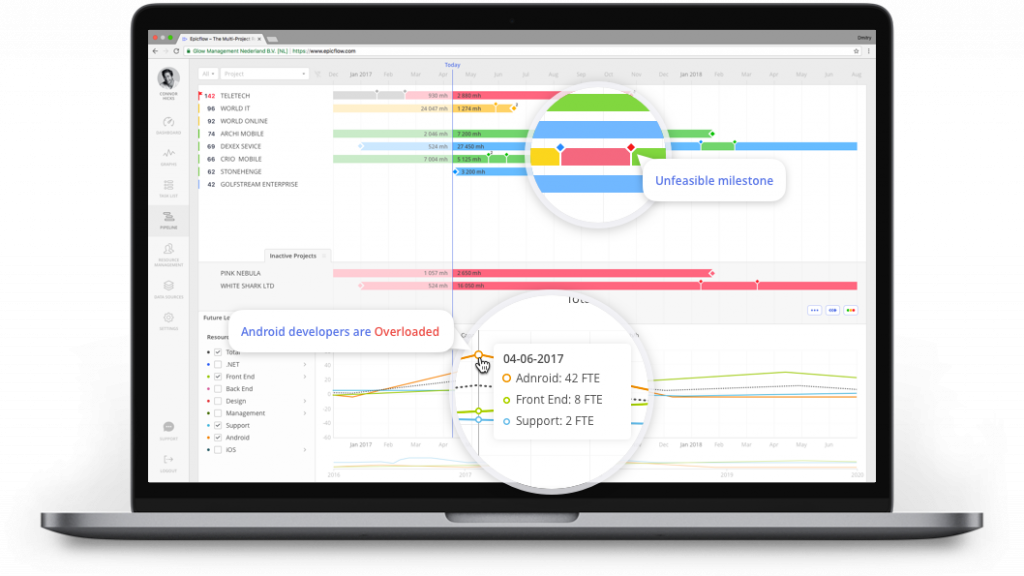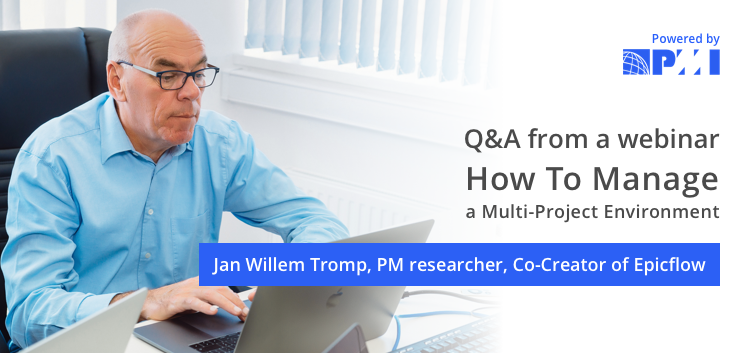On May 8, Jan Willem Tromp, co-founder of Epicflow, was honored to carry out a webinar powered by PMI during which he revealed his approach and gave tips to over 1,700 project management experts. We understand that over 3,000 specialists wanted to participate in the webinar but couldn’t make it. That’s why we’ve collected the main questions from participants of this event into the following Q&A write-up.
Watch: Record of The Webinar ‘How to Manage a Multi-Project Environment’
Jan Willem Tromp has dedicated most of his career to multi-project management and together with Albert Ponsteen has developed a unique approach to resource management for companies that have shared pools of resources. Jan Willem is a marathon athlete and a family man, but he’s also a CEO who wants to know if his projects will be finished on time. To get this knowledge, he first went through the heat of multi-project management and planning research and concluded that most companies have a blurred understanding of their work processes. CEOs think they have dedicated teams, but from our experience a dedicated team in multi-project management is utopian. Jan Willem eagerly shared his opinion during the webinar and answered the following questions.
How can output be doubled by reducing the workload?
There are two steps. First, you have to reduce the workload, so instead of working on ten projects, you’ll work on five projects. This is step number one. And the second step, which is also very important, is that the team must start to focus on their work. If they start a task, then they finish it. Nobody is allowed to disturb the team. This way we reduce the amount of disturbance. This is why the output will most likely increase.
So if you say not to use Gantt charts, how do you recommend tracking resources on various projects?
We know which task has to be performed before the milestones. And we’re tracking the progress and output at the resource level. If you see that all the resource groups have the required output, then you know your projects will flow. If resource groups have lower output, the projects will have problems in the future. This is how we do it.
Read on: The Final Word in the Gantt Chart Polemics

Do I need to replace my project management software for managing multiple projects?
You have to add the multi-project management level. We’re taking the data from your project management system and doing calculations in our own system and then providing you with information on the multi-project management level. You can stay in your current system, whether it’s Microsoft Project, Jira, or something else. It’s all about using the data you already have.
How easy is it to convince executives to freeze projects when they don’t understand the impact on workload?
If your executives are complaining that your projects are delayed all the time and you can prove that the reason is because your people are overloaded, just say to the executives: Let’s give it a try for two weeks and see what happens. This should convince them. All executives are willing to try something—for two weeks, three weeks, you can do it.
Why is a three-week freeze significant?
It depends on the size of the tasks. One or two weeks will not be enough. If one task is estimated at 40 hours, we assume that it will take three weeks to accomplish it.
How do you manage political pressure to prioritize projects?
In a multi-project environment, there will always be political pressure. The only way out is to change the delivery dates.
Can you expand on the “no bonuses for individual PMs” idea?
It’s not just an idea, it’s about the devastating effect if you give your project manager a bonus for delivering a project on time. Be aware that he has to share resources and will fight for them. After your PM gets a bonus, he might think it’s right to choose the bigger guy to accomplish tasks in his low priority projects compared to a higher priority on another project. This PM will ruin the progress on other projects. So you have to balance these things. You’ll get a domino effect. It’s much better to give bonuses to all PMs.
When we talk about multitasking or multi-project resource allocation, what’s the best sequence? Should someone divide a day across three projects or figure out the best combination according to due dates?
If you have a multi-project environment, let the priority calculation decide in which order a resource has to work. Epicflow’s solution for multi-project management will set these priorities for you and give the best possible sequence in the Task List. In our priority list, we also give a number which is called the pressure. If the pressure is high, then be careful in changing the sequence. But if the pressure is low, it means that you still have buffer time and you can switch it around a little bit. The number of the priority is not absolute, it’s relative, and you can play with it. But it’s better to keep with the priority mechanism.
Read on: What Nobody Tells You About Resource Management (But We Will)
How do you evaluate a critical path without using Gantt Charts?
We measure what’s happening at the project level. You can imagine that you have a lot of different paths and one of them is in a critical situation at the moment, so it gets a specific number. This number tells you what the situation is. If the number of a critical path is 100, it means you don’t have any extra time left yet, so you can’t afford any delay. But if the number is 80, it means you have 20% of buffer time compared to the delivery date. On the other hand, if the number is 107, then we normally say you’ll be seven days late no matter how hard you work. The critical path already has a seven-day delay. This is how we work. Because we are fully aware that knowing the status of the project is extremely important for everybody. The priority system takes care that the tasks in the critical path get the highest priority.
You have presented a method close to Critical Chain, where every task has to be started and finished as atomic and cannot be split and shared with others in terms of time and resources. How wise is it to share time and resources among different tasks?
I worked with Eliyahu Goldratt in the past and Critical Chain was part of my daily routine as a project manager. In my opinion, Critical Chain project management can be an excellent methodology in a single project with a dedicated team, but believe me, it does not work in a multi-project environment where you have to share your resources and where the drum—the highest loaded resource—is not stable. Critical Chain assumes that the drum is always stable, but I’ve never seen a multi-project environment where this is the case. It’s utopian. Our software has some familiarity with Critical Chain, especially the Pipeline. Actually, what we did is we took Critical Chain and enhanced it with extra functionality. It was the main reason why we started this journey.
If your questions remain unanswered, you’re welcome to ask them in the comments section and this time they won’t go unnoticed. However, it’s better to hear from Jan Willem or Albert during a live demonstration of Epicflow. Sign up below for a live Q&A session to find out more about our project management software and the philosophy behind it.

